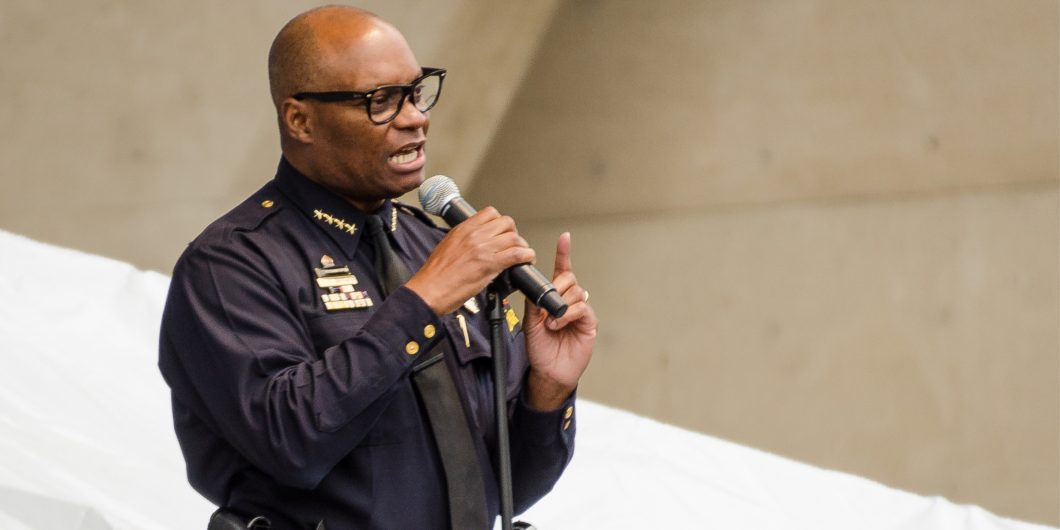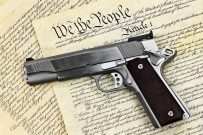Is persistent aerial surveillance a possible answer to Baltimore's woes?
Rethinking Race and Gun Control
Jennifer Carlson’s Policing the Second Amendment: Guns, Law Enforcement and the Politics of Race is a sweeping and provocative recasting of the gun debate. Carlson takes on the Herculean task of providing a framework for thinking about how the right to arms plays out for people of color.
Her inputs are police chief interviews and observations of a carry license review board. “Gun militarism” and “gun populism” replace the traditional pro-gun/anti-gun dichotomy. Policing the right to arms proceeds simultaneously along these two tracks, with gun militarism explaining the tough application of gun laws to criminal “bad guys” (gangbangers, thugs) and gun populism explaining police embrace of armed “good guys” (citizens, ranchers), including those licensed to carry concealed. Both depictions Carlson argues are often “racialized.”
This structure organizes Carlson’s discussion of guns and race and allows her to engage a variety of phenomena that blur the stereotyped boundaries of the traditional gun debate. Though race is her focus, much of the work transcends race. Carlson’s interviews demonstrate in detail that many police, even in racially diverse urban jurisdictions, are gun people.
Police also understand that anti-gun politicians are increasingly hostile to police. One should not be surprised by their response. By guaranteeing anonymity, Carlson allowed police chiefs to “air sentiments that they could otherwise utter only behind closed doors.” In liberal California, for example, the divide between police and progressive legislators has produced a subclass of “gun populism” that Carlson calls “anti-elitism”—where police align with armed good guys against legislators, who “grasp at straws” to “show that they did something” about gun crime. The results, according to the chiefs, are “intricate,” “contradictory,” “unenforceable” gun laws.
Some California chiefs doubt the basic competency of legislators. One wagers that many of them “could not even pass a civil exam.” The output from these politicians is a body of gun regulations so complex that, according to one chief, “most officers don’t even know the law at the entry level. They rely on cheat sheets . . . arrest people and then do the research and then release or charge on the arrest.” Another chief says California gun laws are “an enforcement nightmare that practically require a law degree to understand.” When dealing with armed good guys like the rancher who does not realize his gun or magazine is now illegal, “you have officers who see that and they might not bother enforcing it.”
Traditional boundaries blur again when we fold in black gun owners. Yes, Blacks have voted for the party of gun control since the rise of the modern gun ban movement in the early 1970s. But Blacks also are the fastest growing group of new gun owners and social media has facilitated new black gun organizations that give black gun owners a higher profile that is increasingly difficult to ignore.
Carlson’s illumination of the bias in policing of the right to arms (most powerfully through observations of a carry license review board) adds to the litany of reasons for Blacks to distrust the state administration of gun laws and exercise of discretion over affiliated rights/privileges. These worries, on top of a pile of longstanding reasons for Blacks (and other political minorities) to distrust the state, highlight the increasing difficulty of selling the traditional gun control narrative to such groups.
The loser here is the Bloomberg-style gun agenda. As Carlson elaborates the category of racialized “gun militarism,” one is reminded of Michael Bloomberg dancing away from the throw them up against the wall Fourth Amendment be damned policies that he executed as Mayor of New York. I have long questioned why people so consistently abused would embrace the“just trust the government” mantra of Bloomberg’s Everytown. The black political class buys it because they are embedded in the progressive political alliance. But black gun buying and the rise of black gun organizations suggest a growing grassroots skepticism about progressive gun policies.
Recent history makes the gun control subtext of the police eliminating the need for self-defense an increasingly hard sell. Police are more or less effective depending on who and where you are. The turmoil of 2020 shows that the security bureaucracy is truly a bureaucracy, with multiple variables impacting decisions about how or whether state resources will be deployed to protect innocents. It is no surprise that more and more innocents are unwilling to rely on their safety on such fickle and contingent decisions. For millions of Americans, this includes lawfully carrying firearms in public.
Carlson’s interviews with chiefs dismantle one of the tired old shibboleths about the public carry of firearms. Even before the Supreme Court’s decisions in Heller and McDonald, the majority of states adopted “shall issue” concealed carry policies. But there are still a handful of jurisdictions where carrying firearms outside the home is a restricted privilege of the well-connected few.
The Supreme Court has recently taken a case, New York State Rifle and Pistol Association v. Corlett, challenging treatment of public gun carrying as a privilege rather than a right. As soon as the Court announced it would hear the case, the wailing started about wild west style shootouts provoked by shopping cart bumps. But doomsday projections of what will happen if ordinary people carry guns in public ignore the reality that we have had this debate and already have run the experiment.
Blacks also are the fastest growing group of new gun owners and social media has facilitated new black gun organizations that give black gun owners a higher profile that is increasingly difficult to ignore.
Carlson’s book clarifies things from the perspective of police chiefs who helped administer the experiment. Not only is lawful public carry not a recipe for shopping aisle shootouts, the vast majority of chiefs see armed good guys in the public space as a positive thing in the fight against crime (a strand of Carlson’s gun populism).
Chiefs who extol shall issue in Michigan today had to work through the wave of knee jerk impulses that prop up restrictive carry rules like those being challenged in Corlett. According to Carlson, “On the eve of implementation of the new shall issue law some police officials joined gun control groups in opposing the law. . . . Governor Jennifer Granholm garnered the support of some law enforcement in an unsuccessful drive to block the law.” A decade and a half later, police chiefs recalled the period as “fraught with uncertainty . . . dismay . . . and fearmongering.” One chief confides, “I was mildly concerned at the time but nothing came to fruition.” Another recalls, “when the law changed, my personal belief was that were going to have tons of problems. I was shocked that we didn’t.”
The experience in Michigan is consistent with shall issue licensing in other jurisdictions. Concealed carry license holders are hyper-law abiding. Studies of large numbers of license holders in Florida and Texas show they were arrested for gun offenses at a lower rate than off duty police.
Race is an important detail here. Carlson’s interviews include chiefs, in both majority white jurisdictions and majority black jurisdictions. Most chiefs in both black and white communities “were comfortable with self-defense by private civilians as part of their overall crime fighting mission. They describe the licensing process as a color blind credentialing procedure that identifies “good guys with guns” who are a useful part of the law enforcement matrix.
Also telling is a typical chief’s emphasis on the “ridiculous” presumption that police are adequate protection from criminal endangerment.”
“I believe that citizens need to be able to protect themselves. We cannot protect them. We just can’t. It’s impossible. Here we have the fastest response times [two minutes] and that’s partly the result of population layout. . . . How much can you do in two minutes. The government cannot save people from danger. That’s just ridiculous. So people should be allowed to defend themselves.”
The chiefs uniformly opted out of the highly contested debate over whether more good guys with guns in the public space actually reduces crime. This question has fueled an interminable squabble between economists running and refuting mathematical models that most of us only vaguely understand. But that squabble stands in marked contrast to the more basic, uncontested point that carrying guns does not transform previously law-abiding people into murderers. That will not prevent the claim from being trotted out in the new round of this old debate. It is dispiriting that many people probably still form views about public carry based on this tired old shibboleth.
The broader takeaway here is positive. While some in the political class continue to urge that government will take care of things if we just grant them enough power and surrender enough liberty, an increasingly diverse array of people seem to be rejecting that mess of pottage. Dare one hope for a new resonance of the American origin story in which a measured distrust of government was deemed wise and proper?



